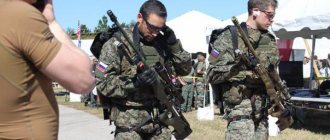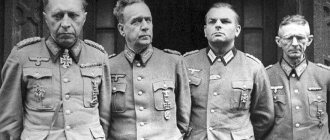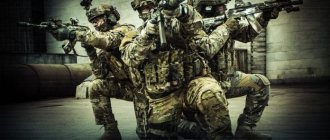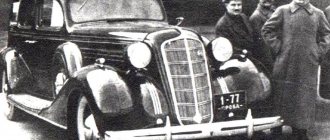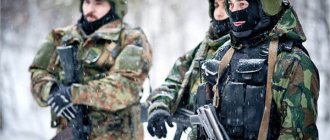Author: KombrigMeNeKolun
24 November 2022 12:15
Community : Sweatpants & Dumplings
Tags: Great Patriotic War GRU Ilya Starinov USSR special forces
5820
11
October 24, 1950 is considered the day of the formation of special forces - special forces of the Main Intelligence Directorate of the General Staff (GRU GSh). At first these were separate companies, later - battalions, and from the end of 1962, special forces brigades began to be formed in military districts.
However, to be precise, the first regular unit of army special forces - a separate special-purpose engineering brigade - was formed in the spring of 1942 on the Kalinin Front, in the zone of action of the 30th Army. It was this military formation that became the prototype of the reconnaissance and sabotage units of the special forces of the GRU General Staff. Ilya Starinov stood at its origins.
0
See all photos in the gallery
Starinov, who was quite deservedly called “the legend of Russian special forces” during his lifetime, played a decisive role in the creation of special sabotage units, developed the basics of their tactics, and created special types of weapons and equipment for their effective operation. Let us once again briefly remind readers of Starinov’s biography, especially of the period when Ilya Grigorievich worked to realize his dream - the creation of army special forces.
×
Hemingway's hero
In 1936, Starinov, at the direction of the GRU leadership, went to Spain as an adviser and instructor for Domingo Ungri’s reconnaissance group. It was necessary to practice methods of waging sabotage warfare. Starinov's idea was simple, like all ingenious things. The main tension during a war, of course, occurs on the line of contact between the warring parties. But the duration of this tension depends, in addition to the moral factor, on the timely provision of the warring units with everything necessary. It is difficult for sabotage groups to operate in the front-line zone: high density of combat-ready units, round-the-clock combat guards. Another thing is the enemy’s extended communications. It is impossible in principle to organize their effective protection. In addition, less combat-ready personnel serve in the rear units. Well-organized and coordinated sabotage activity from the center can significantly paralyze the enemy’s transport network and divert combat-ready units from the front to guard it. In December 1936, Starinov, together with the sabotage group he trained, went out on a combat mission for the first time. During the operation between the cities of Teruel and Calatayud, road and railway bridges were destroyed and the communication line was disabled. After each exit, Starinov carefully analyzed the reasons for success and failure. Constantly improved mines. From several pocket watches purchased with his personal salary, Ilya Grigorievich made time bombs. Near Jaen, fighters from the international brigade joined the ranks of the demolition squad. Starinov quickly increased the size of the detachment, and after appropriate preparation, several groups began to go behind enemy lines at the same time. To break away from the pursuit of the enemy, groups began to use delayed-action grenades for the first time (and today reconnaissance groups, leaving the site of an ambush or sabotage, mine escape routes if necessary). Behind enemy lines, Starinov began to create bases where he stored a supply of explosives and mines. The groups went to the rear lightly, which allowed the fighters to save strength and complete several combat missions in one trip.
0
Near Cordoba, the sabotage group, which included Starinov, managed to derail a large train with the headquarters of the Italian air division. This event caused a great resonance. Mikhail Koltsov and Ilya Erenburg came to interview the miners. On March 23, Ehrenburg’s article about this event appeared in Pravda. Starinov, for obvious reasons, remained in the shadows. Only the initiated knew about his participation in Spanish events. Ernest Hemingway, who was a front-line correspondent in Spain, also met the people of Starinov’s detachment. With the soldiers of the detachment, he took part in several raids behind enemy lines. Based on the collected materials, Hemingway wrote his famous novel “For Whom the Bell Tolls,” where he truthfully, albeit with a slight touch of pathos, described the actions of a sabotage group behind enemy lines. After a couple of months, the mine demolition instructors and commanders of sabotage groups trained by Starinov themselves acted as organizers of sabotage activities, which made it possible to quickly increase the number of groups sent behind enemy lines. As a result, by 1937, the 14th partisan corps was formed, which numbered 5 thousand people. On certain sections of the railway, saboteurs managed to completely block train traffic for several days. The groups also actively used ambush operations on highways: they fired at enemy convoys, captured single vehicles, and used them to move behind enemy lines and blow up bridges. In total, Starinov spent eleven months in Spain. During this time, he created an effective system for training saboteurs. The groups trained by him carried out explosions under almost a hundred trains, destroyed several hundred cars, about 2,000 enemy soldiers and officers, and many bridges and communication lines. The Spanish War was thus the first in which sabotage activities were carried out on such a large scale.
0
During this war, Starinov's military genius was fully revealed. He developed the basis for training and managing sabotage forces in combat conditions, tactics and strategy for their use, and determined ways for the development of special mines and equipment. Ilya Grigorievich summed up the results of his stay in Spain as follows: “The successful use of engineering mines on Franco communications became possible only because we energetically took up the development of this formidable weapon in our homeland back in the early thirties. The mine-clearing tactics and techniques developed by Soviet partisans turned out to be superior to the enemy’s mine-clearing tactics and techniques.” Thus, by 1937, the Red Army received the most modern sabotage equipment and tactics, which were not yet available in other armies. But Starinov’s invaluable experience was completely ignored by the country’s military leadership, and in 1941 Ilya Grigorievich will have to start all over again!
Soviet special forces: from creation to our time
In 1923, the state of the USSR appeared, although its creation was officially announced at the end of December 1922. It replaced Soviet Russia, which existed during the years of the revolution, and became V. Lenin’s new project as a temporary peaceful state.
All pre-war activities of intelligence and state security agencies in the Secular Union are rather interwar, since they developed precisely between two global cataclysms: the First World War, which on the territory of Russia developed into a Civil War, and the Second World War, which in the USSR was called the Great Patriotic War.
Almost immediately, the country began creating special military units. In the 1930s, this process reached its peak: powerful airborne troops and professional sabotage units were created in the Soviet Army. But it must also be said that the process of formation of Soviet special forces took place in difficult conditions. His units were often disbanded - not only because they were ineffective, but very often at the whim of the command. Thus, before the start of World War II, the Soviet special forces were going through hard times - previously disbanded units had to be recreated, while losing a large amount of material and human resources. Moreover, after the end of the war, most of these special forces were disbanded again. That is why the process of creating modern special forces, which began in the second half of the last century, had to start almost from scratch.
Before talking about the special forces of Soviet intelligence, it is necessary to debunk the myth about special forces that has developed thanks to the media. So, when you hear the word special forces, almost every person imagines a group of pumped-up guys with exotic face paint in camouflage uniforms. But this is not his defining characteristic.
The special forces of the Main Intelligence Directorate are units of the regular army that have undergone special training to carry out reconnaissance and sabotage operations behind enemy lines.
Officially, the history of the GRU special forces begins in 1951, when the first sabotage and reconnaissance formations appeared in the Soviet army. But in fact, the formation process began much earlier, even at the beginning of the emergence of Soviet power. Therefore, the predecessors of special forces should include such units as partisan detachments of the Red Army, which operated on enemy territory during the Civil War, special formations of the Western Front during the Soviet-Polish War (illegal military organization), rebel groups that carried out reconnaissance in Eastern Europe in the 1920s, partisan special forces, which were created in the 1930s in case of the outbreak of hostilities on Soviet territory, special forces in the Spanish Republican Army in 1936-1938 (they were created on the initiative of Soviet advisers), as well as reconnaissance, partisan and sabotage units that operated during the Second World War.
The partisan detachments of the Red Army were, in fact, the prototype of modern special forces. Note that both the Reds and the Whites had such formations, but they were significantly different from each other. So, if the Whites used mainly regular units that carried out raids on the flanks or near rear of the RKA, then the Reds mainly used those partisans who were already behind enemy lines. These partisan groups were subordinate to a special unit created within the Operod.
To carry out their tasks, the partisans were supplied with weapons, explosives, ammunition, experienced personnel and money. It should also be noted that, by special decree of V. Lenin, a special school for demolitions was created. It was headed by A. Kovrigin, who very quickly established the effective functioning of the school.
Partisans were specially selected to study at the demolition school. The course of study emphasized special, military and political training. The theory was taught at a school established in the Operod building, and for practice they traveled outside the city. To conduct practical classes, students could use pistols, rifles, special equipment, and field guns.
The work of this intelligence department was controlled by V. Lenin himself.
The losses suffered by the enemy as a result of the activities of partisan detachments were enormous.
Until the beginning of 1920, Poland became the most powerful enemy of the Soviet Union. Until this time, the Polish army occupied most of the Belarusian territory. To carry out sabotage behind enemy lines, an illegal military organization was formed at the end of 1919, initiated by Joseph Unshkhtit (remember, he oversaw intelligence).
We also note that the role of this person in the activities of the Soviet intelligence services is practically unknown to anyone. He was eclipsed by Dzerzhinsky, whose deputy Unshkhtit was at one time. Despite this, it was he who was to lead Poland in the event of the victory of the Soviet Army. And it was he who, until 1930, oversaw the activities of Soviet intelligence abroad, and also led the illegal apparatus of the Comintern.
The creation of an illegal military organization was the result of agreements reached between the command of the Western Front and the Belarusian Social Revolutionaries. In December 1919, a meeting was held in Smolensk, during which the parties signed an agreement on joint actions against Poland. At that time, the Belarusian revolutionary socialist party had about 20 thousand members. In addition, the party controlled the trade unions of telegraph employees, railway workers and teachers. There were also partisan detachments. The Communist Party on Belarusian territory had only 2 thousand people, and most of them were not indigenous people. However, in fairness, it should be noted that already in 1920 another pro-Soviet organization was formed in Belarus, which was called the “Belarusian Communist Organization”.
The unification of all these forces made it possible in a short time to form the People's Military Self-Defense, which at its core was a rebel army operating behind enemy lines. Later it became the basis for the creation of the Illegal Military Organization.
The main goal of the organization was to carry out terrorist acts and sabotage in the rear of the Polish army. But both the organization itself and its activities were classified to such an extent that the front commander did not even know about it. The NVO served several divisions of the Western Front - the 8th, 56th and 17th. 4 NVO members were sent to each of them, each of whom had one assistant and 20 couriers.
At the end of its activity, the organization included 10 thousand partisans.
Since the spring of 1920, graduates of paint committees acted as leaders of partisan detachments. The detachments were tasked with directing their activities to damage telegraph and telephone communications, railways and train wrecks, explosions of bridges, roads and warehouses. In addition, they had to engage in intelligence activities.
The leaders of the NVO were the same people who controlled the intelligence of the front - B. Bortnovsky, A. Stashevsky, S. Firin. The responsible leader of the organization was A. Stashevsky, who three years later, under the name Stepanov, organized a similar structure on German territory, in which there were about 300 groups of partisans.
In general, the activities of the Illegal Military Organization were so effective that even after the end of the Soviet-Polish war, it did not cease to exist, but became the basis for the creation of active intelligence.
After the conclusion of a peace treaty with Poland in 1921, the Intelligence Directorate began organizing and transporting detachments of specially trained soldiers to Western Ukraine and Western Belarus to resist the Polish authorities. All this was undertaken so that a nationwide partisan movement would break out in these territories, which would subsequently lead to the reunification of these lands with the USSR. This activity was called “active reconnaissance.” And, just like the HBO, its activities were kept in the strictest confidence.
In Belarus, the partisan, or more precisely, sabotage movement, arose in the summer of 1921. In 1922-1923 alone, two such detachments carried out a number of operations, among which one can highlight the destruction of a police station in the Belovezhskaya Pushcha region, the seizure and burning of the estates “Good Tree” and “Struga”, the destruction of three landowner estates, the burning of the palace of Prince Drutsko-Lubetsky, explosion of two locomotives, a railway bridge and a railway track on the Lida-Vilno line.
In 1924, partisan detachments carried out more than 80 operations, among which the most famous is the operation in the city of Stolbtsy. During its implementation, more than 50 partisans destroyed the garrison, the village elder, the railway station, the police station and the police department, and also captured the prison and freed S. Skulski (the head of the military organization of the Communist Party of Poland) and P. Korczyk (the head of the Communist Party of Western Belarus).
In the activities of “active intelligence” there were also mistakes. So, in November 1924, 25 partisans attempted to seize a train on the Brest-Baranovichi line, killing one policeman. A chase of 2 thousand people was sent after them. As a result, 16 partisans were arrested, 4 were shot, and another 4 were sentenced to life imprisonment.
As a result of the activities of partisan detachments, the situation on the Polish border became very tense. However, despite all the successful operations, their activities were curtailed in 1925, and the units themselves were disbanded.
The leadership of the Intelligence Directorate, after the disbandment of the partisan detachments, did not abandon the idea of having specially trained saboteurs who could operate behind enemy lines in the event of war. The Soviet command thought about this back in the late 1920s. Therefore, it is not surprising that in 1928-1929, preparations began in the western military districts for guerrilla warfare in the event of an attack on the Soviet Union. The same commanders who acted in active reconnaissance were involved in it.
On the territory of Belarus, 6 detachments of 500 people each were trained. In addition, special sabotage groups were trained at railway junctions. On Ukrainian territory, they trained at least 3 thousand partisan specialists and commanders. There were also large reserves of weapons and ammunition. A special school for training partisans was created in Kharkov, two schools in Kyiv, and special courses in Odessa. Partisan detachments took part in both combined arms exercises and special ones. Thus, in 1933, everything was ready to carry out a surprise operation in the event of an attack on the USSR and paralyze all communications in the western regions of Ukraine, Belarus and Bessarabia. But, despite such preparations, in 1938-1939 all partisan detachments were disbanded. To a large extent, the reason for this was the new military doctrine, which provided that all military operations in the event of war would be conducted on enemy territory. The repression of former partisans caused great damage to the defense capability.
When war began in Spain in 1936, only the USSR came to the aid of the rebels. In the same year, the first volunteers arrived in the country, followed by Soviet advisers who arrived in Spain to help the IRA in the fight against the Nazis. At the end of 1936, the first special forces detachment was created in the country, the instructor of which was the experienced demolition man I. Starinov. The Spanish government was very skeptical about the possibility of waging guerrilla warfare. Therefore, at first the detachment consisted of only five elderly Spaniards, unsuitable for military service. But soon 12 more fighters were sent to the detachment, this time young and experienced. In the suburbs of Valencia, a house was allocated for the detachment, where a school was organized to train fighters.
The detachment carried out its first operation in December 1936, blowing up communication lines and a railway bridge in the Teruel area. After several more successful operations, the number of the detachment increased to 100 people. Soon he was sent to the Southern Front.
The most successful operation of the partisan detachment was the destruction in 1937 of a train containing the headquarters of the Italian air division. The train was derailed from a 15-meter height using a powerful mine. After this operation, the detachment was renamed a special forces battalion.
Later, other, no less successful acts of sabotage were carried out, for example, the detonation of an ammunition train, which picked up a mine and exploded in the tunnel. Such successful activity very soon turned the battalion into a brigade, and then, in 1938, into the 14th Partisan Corps, which numbered more than 5 thousand people. There was a special school in the corps, in which soldiers were taught the intricacies of reconnaissance, sniper work, and mining. Since the corps members had to operate in extreme conditions, they were given double rations and the same salary.
It should be noted that during the entire period of its activity the corps lost only 14 people.
When the Republicans were defeated, part of the corps’ fighters captured the ship and crossed first to Algeria and then to the Soviet Union, while another part crossed the Franco-Spanish border and were interned. When the French authorities decided to hand them over to the Phalangists, they all fled to the mountains.
With the beginning of the Second World War, partisan and reconnaissance and sabotage units again became relevant. Thus, in June-August 1941 alone, more than 180 sabotage groups were sent into enemy territory. The activities of such units were very successful, as evidenced, for example, by the raid of I. Shirinkin’s sabotage group, which in September-November 1941 covered more than 700 kilometers through the territories of the Vitebsk, Smolensk, Novgorod and Pskov regions, conducting reconnaissance and sabotage. For the successful completion of assigned tasks, the commander and commissar were awarded the Order of Lenin.
In the same 1941, on the Western Front, military unit 9903 was created to carry out sabotage activities, which, during the Battle of Moscow, threw N. Galochkin, Z. Kosmodemyanskaya, P. Kiryanov behind enemy lines. In general, by the end of the year, 71 sabotage groups, consisting of about 1,200 people, were thrown behind enemy lines.
The activities of the partisan detachments were not entirely successful. So, for example, out of 231 detachments with a total number of 12 thousand people, abandoned on Belarusian territory in 1941, by the end of the year only 43 detachments with 2 thousand fighters remained. The situation was even worse in Ukraine. In December 1941, 35 thousand partisans were transferred there, of which only 4 thousand remained by the summer of 1942. The result of this state of affairs was mass repressions in the late 30s, when the best personnel and partisan bases were destroyed.
In 1942 the situation improved slightly. After the reorganization of the Intelligence Directorate, an intelligence and sabotage department appeared in the GRU. In the same year, special battalions of miners were organized on each front, which carried out sabotage on important routes of communication and objects.
In 1943, another reorganization of intelligence agencies was carried out. As a result, management of sabotage activities passed to the Intelligence Directorate of the General Staff. This form of leadership remained until the end of the war.
In the post-war period, the main attention of Soviet intelligence was aimed at identifying the enemy's possible preparation for nuclear war. Moreover, it was necessary to prevent even the slightest possibility of using nuclear weapons, as well as to prevent work behind enemy lines.
For this purpose, in 1951, the first sabotage and reconnaissance units were created as part of the armed forces of the Soviet Union. In the shortest possible time, 40 special forces companies were created, the number of each of which was 120 people.
Temporary special-purpose reconnaissance detachments were formed from regular units. The special forces were armed with such types of weapons as machine guns, pistols, grenade launchers, anti-personnel and anti-tank mines, grenades, knives, parachutes, containers for landing radio stations, as well as landing backpacks.
At the beginning of 1950, the Ministry of Defense G. Zhukov came up with a proposal to create a special-purpose corps, but was met with a decisive refusal from the state leadership. After this, the marshal was removed from his post.
However, individual sabotage detachments were united first into battalions, and later into brigades. This is how the GRU brigades appeared. In 1957, separate special battalions were created, and in 1962, special forces brigades were created.
In total, during the heyday of the USSR, 13 brigades of naval and army special forces operated on its territory. Its total number was approximately 15-20 thousand people.
With the beginning of the Afghan war, a new stage began for the GRU special forces, which became a serious test of strength. The “Muslim battalion”, which later stormed Amin’s palace, included mainly representatives of eastern nationalities - Uzbeks, Tajiks, who knew the local language well. The Slavs were present only in the crews of the ZSU-23-4 “Shilka”.
It is worth noting that this battalion was not the only one. At the end of December, the 1st special forces detachment, numbering 539 people, was introduced into Afghanistan. And in January 1980, the head of the GRU, Ivashutin, announced the need to create two more detachments of 677 people each.
In March 1985, as the situation in Afghanistan became more complicated, it was decided to introduce additional special forces units into Afghan territory, on the basis of which two brigades of 4 battalions of 3 thousand people each were created.
The activities of the special forces alternated between victories and defeats. For example, in 1986, special forces seized 14 tons of opium that was being transported from Pakistan, for which local drug dealers sentenced brigade commander Gerasimov to death. In October 1987, one of the groups, carrying out an operation to intercept weapons, was surrounded and suffered heavy losses, then 14 out of 26 people died.
Combat swimmers became another type of GRU special forces units. Their appearance was the result of the successful activities of Italian underwater reconnaissance saboteurs during the Second World War.
Until 1952, such detachments appeared in almost all NATO member countries; in the USSR, the need to create a special detachment of swimmers was thought about only in 1956, after combat swimmer L. Krabs died in England during an examination of the Soviet cruiser Ordzhonikidze.
However, consideration of the need to create such a detachment was delayed. It was only in 1967 that a decree was signed on the creation of the “Education and Training Squad of Light Divers.” During the exercises, combat swimmers not only conducted reconnaissance of the coastal waters, but also went ashore and undermined communications and warehouses of the mock enemy. The results impressed the officers so much that this detachment became the first unit to combat underwater sabotage means and forces.
Combat swimmers were almost never left without work. In 1967-1991 they worked in Angola, Mozambique, Ethiopia, Vietnam, Cuba, Korea, and Nicaragua.
Marine animals were often used for combat operations. The first, of course, were the Americans, who, with the help of dolphins, killed more than 50 saboteur swimmers during the Vietnam War. In the USSR, the first special unit for working with animals appeared in 1967 in Sevastopol. The experiments involved 70 dolphins, who were taught to detect underwater and surface objects, guard them and give signals in the event of strangers approaching.
Animals were also used as living torpedoes, which were aimed at submarines, aircraft carriers and destroyers. The dolphins remained at sea with mines attached to them for weeks, and when the enemy approached, they attacked him.
After the collapse of the Soviet Union, the situation changed for the worse. There was no money to maintain the dolphinarium, so the management turned to business. As a result, only 6 trained dolphins remained.
Today in Russia there are only 4 special-purpose brigades, and 2 of them were transferred to the Airborne Forces back in 1994.
Military intelligence special forces have always guarded the interests of the state. The special forces were always the first to enter battle and the last to leave it. Therefore, modern fighters have something to be proud of and something to strive for.
Out of the frying pan into the fire
While Starinov fought in Spain, many senior and middle-level military personnel were repressed. Most of his colleagues and acquaintances were also arrested. All preparations for guerrilla warfare, which Starinov and his associates carried out in the 30s, were called “a conspiracy to overthrow the Soviet government.” After returning to his homeland, Ilya Grigorievich’s feeling of honestly fulfilling his military duty gave way to despair. Starinov personally reported his participation in the Spanish events to the People's Commissar of Defense Voroshilov. Voroshilov highly appreciated Starinov’s merits and recommended that his superiors promote Ilya Grigorievich in rank and position. Starinov was awarded the Orders of Lenin and the Red Banner. But instead of promotion, Starinov was summoned to the NKVD and interrogated about the purposes of forming secret partisan bases and about the training of partisan personnel in the 30s. Seeking protection from persecution, Starinov turned to Voroshilov, and the People's Commissar of Defense was able to protect him. Thus, Starinov was one of the few who managed to avoid arrest. And at least 10 thousand people were repressed in this case: the entire leadership of the GRU, the heads of intelligence of the western military districts, almost all the leaders of partisan detachments, and ordinary partisans were arrested. Fortified areas and partisan bases were liquidated.
Order and expungement of criminal record
Individual guards battalions recruited exclusively volunteers. Candidates for demolition miners were required, first of all, to have courage, resourcefulness, the ability to navigate and quickly make decisions in any situation:
“...Having received permission to replenish the battalion in small batches - my outfits were issued for 10-15 people - I went to the reserve regiment myself and selected reinforcements from people prepared to be sent to the front,” recalled Alexander Galli, “I did not strive to get sappers , who knew sapper business well, since the engineering training of a battalion of miners differed sharply from the profile of training of linear engineering units... I paid the main attention to ensuring that people, if possible, were fired upon, if possible, I chose former intelligence officers and gave preference to Siberians and hunters... Usually more people came out than I needed - 50-60 people, but since I needed to choose 20 people from them, the company commander and I first talked with everyone who expressed a desire, and even exaggerated the colors so that people would not think that this will be a fun job."
Map showing an enemy train derailed by a group of miners from St. Lieutenant S.P. Bykova. Photo: pamyat-naroda.ru
Brave and desperate people were selected for the battalion, including those with a criminal past, who atoned for their debt to the Motherland with blood: “Once during the selection, a Red Army soldier came up to me, asked permission to contact me and asked to take him to my unit, and his tone was unsure that I would take it. I asked his age, whether he had been to the front, what he was doing in the reserve regiment and what his specialty was. “You won’t hire me, this is my specialty.” - "Which?" - “Yes, I stole horses.” I looked at him and asked: “Aren’t you afraid to join our battalion?” - "No". - “So I will need you.” ...
In his story A.P. Galli also mentioned another fighter: “...In this regard, Chernyaev did better. He is a very experienced miner. It must be said that he was a bandit in the past, he has 36 convictions, which taught him to be extremely careful. With his brilliant actions, he deserved that all his criminal records were cleared, and he was awarded: the Order of Lenin, the Order of the Patriotic War, 1st degree, and a number of other awards.”
From the award list of Guards. ml. Sergeant Chernyaev V.V. dated February 4, 1944:
"Guards Jr. Sergeant Chernyaev V.V., has been in the rear since July 30, 1943. During this period he showed himself to be a courageous and proactive commander. From 10/1/43 to 1/1/44, Comrade Chernyaev, commanding a group of miners, 10/17/43 on the railway. Ostrov-Rezekne blew up a military transport train: a steam locomotive and 14 wagons with food. 20.11.43 on the railway Ostrov-Rezekne blew up a military train, resulting in the destruction of a steam locomotive and 9 wagons with bread. 11/21/43 on the same road a military train was derailed, a steam locomotive and 10 open carriages with soldiers were destroyed, where up to 200 soldiers and officers were killed. During ambushes and raids on enemy garrisons, he blew up three cars, a tractor, a threshing machine and killed 21 Nazis. During the entire period of his stay in the rear, Comrade Chernyaev derailed 4 transport trains, of which, according to updated data, in the derailed train 8.9.43 years on the railway. Pskov-Rezekne killed 176 and wounded 319 military officers. He blew up 4 wooden bridges, destroyed 30 German soldiers and officers, captured 8 Nazis, blew up a creamery and others.”
Start of the war
0
With the beginning of the Great Patriotic War, Starinov was appointed commander of an operational engineering group, whose tasks included the destruction of transport infrastructure in front of the advancing enemy. In the two sapper battalions that were placed at the disposal of Ilya Grigorievich, there was one rifle per three soldiers, and there was almost no engineering equipment. Nevertheless, Starinov’s group was very successful. She managed to destroy dozens of bridges. Since the Germans were literally on the heels of the retreating Soviet troops, delayed-action mines (DAMs) were required. Without waiting for the arrival of regular MZDs, Starinov began to manufacture them in the field. Installed in a pile of rubble or covered with cobblestones, MZDs turned into stone throwers - a kind of directed action mines (DAM). Mines set to non-removable exploded when an attempt was made to clear them. After the war, standard mines will be created on the principle of a directed explosion: MON-50, MON-100 and others, which are very widely used today in all military conflicts. At the beginning of July, Starinov sent the first sabotage group behind enemy lines, which mined the road and successfully blew up several cars.
Head of the first partisan school
On July 13, by order of the People's Commissar of Defense, Starinov was appointed head of the first front-line partisan school of the Western Front. Arriving in Roslavl, where the school was located, Starinov quickly became convinced that none of the people responsible for training partisans had any idea about the tactics of partisan detachments. Everything had to start all over again, the experience of the 30s was lost, the personnel was destroyed! Planned training of partisan personnel began. Sixty hours of preparation - and the partisans were sent behind enemy lines. The school was constantly moving east. The war was approaching Moscow. Sabotage instructors trained at the school were transferred to other schools. At the end of July, Starinov was sent to Kyiv, where he had once served and where there was a powerful center for training partisan personnel. Not a single former instructor could be found! The training of the partisans was carried out by party officials who understood nothing about it. Starinov taught classes in Kyiv for five days, later held short classes in Chernigov, and organized a school in Orel. In September, groups from Tula and Kursk arrived in Orel for preparation. Starinov, thus, organizes the training of sabotage personnel on the scale of several fronts, regions, and three union republics. In fact, he turned out to be the only specialist in the Red Army who knew sabotage. In the second half of September, Starinov received the task of mining and destroying the most important industrial and transport infrastructure of Kharkov. Starinov received the order to carry out the work at the Headquarters of the Supreme High Command personally from the Chief of the General Staff Boris Shaposhnikov. In Kharkov, Starinov’s detachment laid hundreds of mines - this was the first time such a scale of mining was used during the war. In one of the party mansions, Ilya Grigorievich installed a high-power radio mine. On the night of November 14, a powerful radio station in Voronezh gave a signal to blow it up. In a mined mansion, the commandant of Kharkov, Lieutenant General Georg von Braun, and the headquarters officers of the 68th Infantry Division were blown up. This act of sabotage was included in the annals of sabotage art and special textbooks. Together with Starinov, the Spaniards, whom he trained in sabotage in Spain, took part in the mining of objects in Kharkov. Starinov managed to get a group of Spaniards accepted into the engineering units. In the future, he will carry them with him on all fronts.
0
Despite the threats of Mehlis
On November 28, Starinov was appointed to the post of assistant chief of staff of the Red Army engineering troops. He writes a letter to Stalin about the need for mass production of special anti-vehicle mines and the organization of sabotage activities behind enemy lines. Starinov is summoned to Headquarters. Instead of Stalin, he was received by the representative of the Headquarters, Lev Mehlis, who failed to prove anything. Moreover, Mehlis promised to shoot Starinov if he did not stop bothering Stalin with “nonsense.” Instead of planned sabotage work in the rear, Headquarters decided to give the partisans the task of burning forests and villages (in winter!), i.e. to deprive partisans of shelter and shelter over the heads of Russian people who fell into occupation. Ignoring Mehlis’ threats, Ilya Grigorievich sent Stalin another letter, which finally had an effect. A special meeting was held at the State Planning Committee, to which Starinov was invited, and by spring, new mines began to arrive en masse to the troops and partisan detachments.
Cossack experience
In Russian military history there are many examples of special forces participating in combat operations. In the second half of the 18th century, huntsman units were created in the Russian army, and the Cossack army reconnaissance - Cossacks-Plastuns, universal military units capable of performing the most complex tasks - also gained great fame. During the Patriotic War of 1812, the flying partisan detachment of hussars and Cossacks of Colonel Denis Davydov bravely fought against the Napoleonic invaders.
Scheme of the “wooden mine” Kovalev-I (DMK-I). MUV is a universal instantaneous mine fuse. Photo: pamyat-naroda.ru
In Soviet Russia, measures were also taken to create special-purpose units, the first of which was the formation in 1918 of special-purpose units (CHON) of the Cheka, which were intended to fight the Basmachi in Central Asia and rebel movements on the territory of the RSFSR.
In the 1930s, the USSR began to create airborne troops and professional sabotage units - camouflage sapper platoons.
Among the special forces, we should highlight the Separate Motorized Rifle Brigade for Special Purposes (Omsbon) of the NKVD of the USSR, created on October 2, 1941. In January 1943, the brigade was reorganized into a special-purpose detachment under the NKVD-NKGB of the USSR.
The miners acted both separately, performing sabotage and reconnaissance missions, and took command of partisan detachments
This list can be continued further, since during the war years special forces units existed in almost all types and branches of the Red Army and Navy.
By the way, the techniques of plastuns were used in the training of units of guards-miners. For example, the art of camouflage, silent movement, the ability to build traps for the enemy and hit any target in conditions of poor visibility and even in its absence, and much more.
First special purpose military unit
In the spring of 1942, Starinov first raised the question with his superiors about the creation of special brigades for operations on enemy communications, and met with the commander of the airborne troops, Glazunov. After this meeting, experienced instructors were sent to the Airborne Forces to train paratroopers in the basics of sabotage tactics and mine demolition. But Starinov believed that it was necessary to create special forces for operations behind enemy lines.
That same spring, Starinov again found himself on Tver soil. He was sent to the headquarters of the engineering troops of the Kalinin Front to organize work on the construction of mine-explosive barriers. But, in addition to his main work, Ilya Grigorievich is again trying to create special sabotage units for operations behind enemy lines. With this idea, he turned to the front commander, Lieutenant General Ivan Konev. Konev immediately appreciated Starinov’s idea and immediately gave the order to form a special sabotage brigade on the basis of the airborne troops. “From the very beginning, the business gained rapid momentum,” recalled Ilya Grigorievich. Konev contacted the Chief of the General Staff, Alexander Vasilevsky, and asked him to receive Starinov. Vasilevsky gave the green light to the creation of special sabotage brigades and instructed Starinov to head a separate special-purpose engineering brigade on the Kalinin Front. On Vasilevsky’s instructions, Ilya Grigorievich also developed a draft order for the creation of special units on all fronts, a plan for disrupting movement along enemy communications on the Western and Kalinin fronts.
0
The brigade included three battalions of the 5th engineering brigade and the 110th separate motorized regiment. From the cadets of the Nakhabinsk Engineering School, Starinov selected commanders of sabotage groups. In addition, he achieved secondment to a brigade of commanders with whom he served near Kharkov and Rostov, as well as a group of Spaniards. The first commanders of the brigade groups were Captain Kazantsev, senior lieutenants Chepak, Romanyuk, Ilyushenkov. Their first deployment behind enemy lines took place in the sector of the 3rd Shock Army. Some groups had to join forces with partisan detachments, while others had to act independently. A special school for training miners for partisan detachments was also created at the northwestern group of the Central Committee of the Communist Party of Belarus (Bolsheviks), at the headquarters of the Kalinin Front (the group was located in the village of Sheino). At the request of Starinov, Konev restored all the Spaniards to their previous ranks, some were appointed to the positions of commanders of sabotage groups, others were sent as mine demolition instructors in partisan detachments. The groups of senior lieutenant Romanyuk, lieutenants Sokolov and Criulin, and the Spaniards Canel, Francisco Gaspar, and Chico Mariano were the first to be withdrawn behind enemy lines. Groups of Senior Lieutenant Chepak went out to carry out sabotage on the Smolensk-Vyazma railway. The main efforts of the groups were aimed at disrupting the supply of enemy material and personnel to the Rzhev enemy defense center. For the first time, the question of special food sets with increased calorie content for abandoned groups was also raised. A sabotage school was also created in Valdai in the zone of action of the North-Western Front. Unfortunately, there were not enough portable radio stations, and, having used up the supply of mines and explosives, the groups were forced to return back across the front line, losing precious time and effort. There were not enough special mines, and Starinov established their production in Kalinin. In the Kalinin Front zone, in case of a possible summer retreat of the Soviet troops, 46 warehouses with weapons and mines were laid down. In June, 73 groups of miners went behind enemy lines. There were almost no casualties among personnel. Starinov was still convinced that special troops needed to be created to operate behind enemy lines. And he again writes a letter to Stalin. The idea of creating troops was warmly supported by Konev. In Moscow, following this letter, Starinov met with Voroshilov, Kalinin, Secretary of the Central Committee Malenkov, and Chief of the General Staff Vasilevsky. To replenish the brigade with Spaniards, Starinov turned to the General Secretary of the Executive Committee of the Comintern Dimitrov. Dimitrov was keenly interested in the tactics of the sabotage groups and asked questions about the possibility of using their experience in the fight against the fascists in the occupied territories of Europe. After this meeting, one hundred more Spaniards were sent to the brigade. The creation of special forces was just around the corner. On July 23, the Sovinformburo reported that the unit, commanded by Colonel Starinov, derailed 10 enemy echelons. Starinov corresponds with the command of neighboring fronts. The preparation of sabotage groups was also carried out on the Karelian, Western and Southern fronts. Documents on the creation of special-purpose engineering units were about to be signed.
Behind enemy lines
But Starinov is unexpectedly called to Moscow and sent to work at the Central Headquarters of the Partisan Forces. On August 17, 1942, by order of the People's Commissar of Defense, separate guards battalions of miners and a separate guards brigade of miners were created at Headquarters “for mining and destruction of communications behind enemy lines.” On the Kalinin Front, the 10th separate guards battalion of miners was formed. Few people from the 5th brigade were included in it, but the 160th and 166th battalions of the brigade continued to operate effectively in the rear. The battalions were particularly active behind enemy lines from April to August 1943. In the summer of 1943, entire companies of miners began to land behind enemy lines. During the fighting, seven soldiers from the brigade were awarded the title of Hero of the Soviet Union: senior lieutenant Kolosov, senior sergeant Goryachev, sergeant Yablochkin, junior sergeant Efimov, privates Bazalev, Bezrukov, Myagky. Hundreds of miners were awarded military orders and medals. The commander of the sabotage group, Lieutenant Andrianov, led six hundred civilians out of the occupied territory in August 1943. In September of the same year, Andrianov’s group of 25 people captured and disarmed 88 enemy saboteurs. In June 1944, the group, together with a detachment of partisans, was surrounded. The battle lasted all day. During the breakthrough, Andrianov died. After the war, the Volga motor ship was named after “Peter Andrianov”. Thus, Starinov was on Tver soil from spring to mid-August 1942. This period is considered one of the most important stages in the creation of special forces.
To the partisans as commanders
Throughout the war, from December 1942 to May 1945, the battalion was permanently commanded by Guard Lieutenant Colonel Alexander Petrovich Galli.
This is how he himself described the main differences between the combat operations of demolition miners and army reconnaissance units:
“It should be said that the conditions for the actions of guardsmen behind enemy lines in most cases differ from the actions of conventional military reconnaissance. Signs of such reconnaissance are the significantly greater depth in which we operated, a longer period of stay on the mission, which was calculated for us from 2 to 3 weeks, and sometimes more. In this regard, by the nature of their combat activities, the miners were closer to partisans or human intelligence than to ordinary military intelligence.”
When carrying out combat missions of command deep behind enemy lines, the guardsmen-miners closely interacted with partisans and active units of the Red Army, which determined the nature of their activities:
“...When they acted separately, then the miners carried out both sabotage and reconnaissance tasks, and when they acted together with the partisans - for example, according to the experience of my battalion, as well as other units - they either remained commanders of individual units, such as the corporal Burda and Sergeant Kurakov commanded platoons of partisans. Platoon commanders commanded companies of partisans and even detachments. In this case, the guardsmen cemented or organized them and also trained them. When sappers acted together with mobile troops in the depths of the enemy’s defense, in this case they played the role of ensuring the advancement of these troops, and also conducted reconnaissance ... "
"Rail War" or "War on Rails"?
0
At the Central Headquarters of the partisan movement, Starinov headed a school for training miners and a technical department for the production of special mines. In January 1943, Starinov went to the Caucasus to plan operations behind enemy lines. He took with him a significant group of Spaniards. 16 sabotage groups were parachuted behind enemy lines in the area between Rostov, Salsk, Tikhoretskaya and Krasnodar at intervals of several days. Later they began to develop operations to withdraw groups behind enemy lines on torpedo boats to the areas of Novorossiysk and the Crimean Peninsula. The practice of using sabotage groups and their tactics have been improved. Usually the size of a group was 5-7 people, a detachment - 20-30 people. At night - movement and sabotage, during the day - organization of day trips and observation. The greatest difficulty was evacuating the groups. To extend the period of their operations behind enemy lines, food and ammunition were transferred by air to the groups. On March 7, 1943, the Central Headquarters of the partisan movement was disbanded. The school headed by Starinov was also disbanded. He was transferred to the Ukrainian headquarters of the partisan movement. As deputy chief of staff, Starinov himself determined the scope of his responsibilities: he created a department for training saboteurs and planning sabotage operations. As before, Starinov manages with great difficulty to defend his opinion on the principles of the use of partisan and sabotage forces. The command continued to plan operations where the partisans had to go into a head-on collision with the enemy. In such battles, the partisans' forces quickly dried up, since they did not have heavy weapons, ammunition supplies were limited, and the accumulating wounded reduced the mobility of the units. Starinov saw the main thing in partisan tactics as sabotage on communications. This required incomparably less ammunition and explosives, and the effect was much higher. The Battle of Kursk was approaching, and Starinov left for the Voronezh Front. The tasks are still the same - disrupting enemy transportation along railways and highways. As Starinov notes, during the preparation for the Battle of Kursk, the higher command finally came to understand that mines are not only defensive, but also offensive weapons. Of course, one of the “culprits” for realizing this reality was Starinov, whose successful experience on absolutely all fronts spoke for itself. The most amazing thing is that Starinov managed to convince the leadership to abandon the “rail war” and wage a “war on the rails.” As a result, it was his plan for a massive strike on enemy communications that was adopted. To coordinate the efforts of the partisan detachments, Starinov flew behind enemy lines. During the Great Patriotic War, this was his first flight behind the front line. In the partisan detachments of Kovpak, Fedorov, Saburov, Vershigora and others, Ilya Grigorievich conducts training for miners. For the first time, large-scale use of MZD on railways was planned.
They didn’t abandon their own, they didn’t give up
And self-sacrifice and help to a comrade were also required from each guardsman. There were no cases where a wounded man was abandoned on the battlefield. Even in conditions when Sergeant Major Chernyaev’s group was surrounded by the enemy in the forest south of the Island, they managed to carry out the seriously wounded soldier Petrov and break through the encirclement.
There were no cases of surrender to the enemy among the guardsmen.
As for the equipment and weapons of the guards, then, according to Galli, practice has shown that the miner is not able to fight and move freely behind enemy lines when he is overloaded. Maximum load - 30-35 kilograms, including uniforms, ammunition, food, explosives...
The miners acted both separately, performing sabotage and reconnaissance missions, and took command of partisan detachments
The main weapon was a machine gun. Mainly, they tried to use their PPS-type machine gun, which was convenient to hide and which was lighter. Sometimes, if they had captured weapons or ammunition, they used German machine guns. This was also convenient because the enemy could not tell by sound where they were and where they were. Each miner, if possible, was given a pistol, especially when operating on enemy territory, when he had to dress in civilian clothes and enter populated areas. The gun was also an indispensable weapon, and at least 2-3 RG-42 grenades without a handle. Each miner was allowed to take with him as much ammunition as he could carry before taking off and landing.
As the battalion commander noted, the demolition miners behind enemy lines tried to diversify their tactics and fight creatively, not according to the template.
“For example, since the end of 1942, we, as a rule, used a description of the theater of military operations, used the astronomical calendar for sabotage, and carried out a number of other measures when developing tasks, i.e. do not order sabotage on a moonlit night if the objects were guarded, and vice versa, if the objects were not guarded, choose a moonlit night...”
The daily march ranged from 15 to 20 kilometers, near the front line - up to 25 and even 40 kilometers deep behind enemy lines. When passing through populated areas not occupied by the enemy, this was done unnoticed by the civilian population. If you had to ask the locals for directions, then intelligence was interested in not one, but several routes so that the person being asked could not understand which route the group was interested in. To avoid spying, they did not take the route that was of interest to the miners.
Beautiful and effective idea
0
On July 5, 1943, the Battle of Kursk began. Starinov believed that if the partisan detachments were promptly provided with the necessary number of mines, explosives and specialists, then the enemy’s communications could be completely paralyzed. Moreover, he was confident that already in 1942 it would be possible to completely paralyze the enemy’s supply by rail on all fronts. Subsequent events showed that Starinov’s calculations turned out to be correct. Dozens of sabotage groups laid hundreds of mines on all railways leading to the front line in the southern direction. And again - a beautiful and brilliant idea. At the same time, in one area, the saboteurs set a dozen MZDs to be non-removable (the mines exploded when trying to clear them) with different deceleration times. The first mine is placed on a combat platoon - the first echelon of the enemy is blown up. The Germans are checking the road, strengthening security, and sending trains back in. Some of them manage to get through, which dulls the vigilance of the guards. At this time, the saboteurs place a second mine on combat platoon, and the next train goes downhill. The Germans are combing the forests in search of partisans, but the Nazis do not realize that the mines are already in the roadbed. So successively the mines wait for the end of their deceleration period, become armed and explode from the vibration of the train passing from above. In the end, without finding an answer and without eliminating the cause, the enemy was forced to completely stop moving along the section of the road. Thus, only Fedorov’s detachment from July 7 to August 10, using the MZD, derailed 123 enemy echelons, while over the previous 16 months - only 65. To destroy the same number of echelons from the air would have required hundreds of sorties, hundreds of tons of aircraft explosives, the inevitable loss of dozens of aircraft. The enemy hastily sent more and more units to guard communications, but the mines continued to explode. As a result of the actions of the saboteurs, the supply of troops along many railways was completely (completely!) paralyzed. In total, in the second half of 1943, partisans derailed 3,143 trains! In terms of effectiveness, partisan sabotage was 100 times more effective than aviation! And if the partisan detachments acted in concert, they would be able to paralyze movement over a vast territory. To understand this simple idea, which Starinov insisted on all the time, it took two difficult years of war and millions of dead.
Both mine and finka
One of the main subjects of training for special forces miners was, of course, demolition (mine training). The guardsmen had to know all types of mines and be able to use the available demolition means in order to make a mine themselves. In addition, they had to master various methods of mining highways, dirt roads and railways.
Commander of the 9th Brigade A.P. Gally. Photo: pamyat-naroda.ru
For example, due to the lack of air supply and the lack of explosives and ammunition from November 1943 to January 1944, miners were forced to use available trophies for demolition - shells that were stolen from the Germans from poorly guarded stacks. In these cases, either the projectile was unloaded and melted out of it, or a igniter was placed on the head of the projectile.
During tactical training, special classes were conducted with miners with an emphasis on conducting mobile combat. They took place mostly in the forest at night, especially in winter, and taking into account some of the features of guerrilla tactics. Namely: practicing silent concentration at the line of attack, usually a populated area or forest in which the enemy garrison was located, speed and surprise of actions, the ability of groups to strike simultaneously from different points against one common object and the ability to quickly disperse in different directions after an unsuccessful attack or fight.
An integral quality of the miner guards was mastery of all types of weapons in service with the battalion. In addition to their weapons, all miners knew such types of German weapons as a machine gun, a Mauser rifle, pistols of various systems and light machine guns MG-34 and ZB-53.
Over the course of a year, the soldiers of the Galli battalion derailed 110 trains behind enemy lines, blew up about 80 bridges, and killed 1,473 fascists in battles and ambushes.
At the last stage of hostilities, there was an urgent need to learn and be able to shoot with a sniper rifle, since when the miners went to join forces with Red Army units, under conditions of enemy retreat, a disguised sniper knocked out up to 10-15 people, destroying mainly enemy officers .. In addition to firearms, each miner was properly armed with a bladed weapon, a finka or a dagger, and underwent special training in mastering it on bags. They all knew how to use devices for silent shooting - BraMites.
Great attention was paid to the physical training of soldiers and commanders. A striking example is the passage of two groups of miners in February 1943 across Lake Ilmen. Having covered about 60 kilometers in 10-12 hours, the group came across a German ambush and, after a short battle, unable to get behind enemy lines, was forced to begin a retreat. She made it without losses, and returned to her location after 36 hours, having thus covered about 150 kilometers.
They didn’t recognize it because they were afraid
During the Great Patriotic War, Starinov fought on almost all fronts, created dozens of schools for training saboteurs, laboratories for the production of mines, and personally trained over 2,000 demolitionists. His students and the miners they trained derailed about 12,000 enemy trains. He was on the list of Hitler's personal enemies. It was Starinov who made a decisive contribution to the creation in 1950 of special forces - the special forces of the GRU General Staff. He developed in detail the tactics and strategy for its use, and created dozens of samples of special equipment. It was Starinov who was able to prove in practice that “mines are not a defensive, but a purely offensive weapon”, that “a mine planted in the right place hits without a miss,” unlike a blind projectile.
Life is like a feat
0
Even during the civil war, Starinov seriously undermined his health, developing severe rheumatism. During the Finnish War, he received a severe disability, which allowed him to leave military service. Doctors gave Ilya Grigorievich, with proper adherence to the regime, 50 years to live. Strict self-discipline and a healthy lifestyle (he never drank or smoked, and was constantly involved in physical exercise) allowed him not only to live to be a hundred years old, but also to go through four difficult wars. Starinov was nominated for the rank of general five times, and three times for the title of Hero of the Soviet Union. But he received neither one nor the other - too often a professional of the highest level did not agree with his superiors, too often he openly defended his opinion.
0
